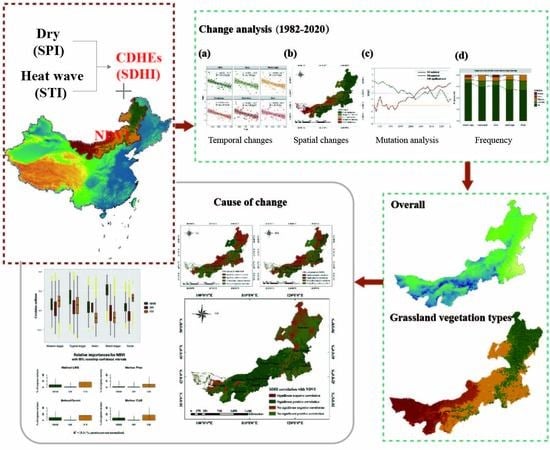Spatiotemporal Variation in Compound Dry and Hot Events and Its Effects on NDVI in Inner Mongolia, China
Abstract
:1. Introduction
2. Materials and Methods
2.1. Study Area
2.2. Data Sources
2.3. Methods
2.3.1. Construction of Indices of Dry and Hot Extreme Events
2.3.2. Spatiotemporal Variation Analysis
2.3.3. Mutation Analysis
2.3.4. Partial Correlation Analysis
2.3.5. Relative Importance Analysis
3. Results
3.1. Characterization of SDHI Change
3.1.1. Temporal Variation in SDHI
3.1.2. Spatial Variation in SDHI
3.1.3. Frequency Ratios of SDHI for Different Grassland Types
3.2. Characterization of NDVI Change
3.2.1. Temporal Variation in NDVI
3.2.2. Spatial Variation in NDVI
3.3. Correlation Analysis between SDHI and NDVI
4. Discussion
5. Conclusions
- In terms of spatial and temporal variation characteristics, in the past 39 years, Inner Mongolia was dominated by the occurrence of abnormal compound dry and hot events, and the overall compound dry and hot event severity increased. Among different grassland types, the SDHI value of typical grassland had the largest decrease rate of 0.03/year. The overall NDVI showed an increasing trend of 0.0013/year (p < 0.05), and the areas with significant increasing trend of NDVI values were mainly distributed in forest, meadow steppe, and typical steppe.
- The overall positive correlation between SDHI and NDVI was observed in Inner Mongolia, and the mean value of partial correlation coefficient between SDHI and NDVI was 0.68, showing a spatial response characteristic of strong in the middle and gradually weakening to the east and west sides. SPI was positively correlated with NDVI values in 52.21% of Inner Mongolia, and temperature conditions both promoted and inhibited vegetation growth in Inner Mongolia.
- In terms of different grassland types, different vegetation types showed different characteristics dependent on complex climatic conditions, with woodlands being more sensitive to changes in temperature conditions than grasslands, and desert steppe and typical steppe being the most dominant to changes in the SDHI. The combined contribution results show that temperature conditions contribute more to the vegetation change in Inner Mongolia Autonomous Region than precipitation and compound dry and hot conditions.
Author Contributions
Funding
Institutional Review Board Statement
Informed Consent Statement
Data Availability Statement
Acknowledgments
Conflicts of Interest
References
- Guo, E.L.; Wang, Y.F.; Bao, Y.H.; Sun, Z.Y.; Bao, Y.L.; Lai, Q. Spatiotemporal variation of heat and cold waves and their potential relation with the large-scale atmospheric circulation across Inner Mongolia, China. Theor. Appl. Climatol. 2020, 142, 643–659. [Google Scholar] [CrossRef]
- Wang, Y.F.; Liu, G.X.; Guo, E.L. Spatial distribution and temporal variation of drought in Inner Mongolia during 1901–2014 using Standardized Precipitation Evapotranspiration Index. Sci. Total Environ. 2019, 654, 850–862. [Google Scholar] [CrossRef] [PubMed]
- Liu, X.; Tian, Z.; Zhang, A.; Zhao, A.; Liu, H. Impacts of Climate on Spatiotemporal Variations in Vegetation NDVI from 1982–2015 in Inner Mongolia, China. Sustain.-Basel 2019, 11, 768. [Google Scholar] [CrossRef]
- Li, X.F.; Wang, S. Recent increase in the occurrence of snow droughts followed by extreme heatwaves in a warmer world. Geophys. Res. Lett. 2022, 49, e2022GL099925. [Google Scholar] [CrossRef]
- Hao, Z.C.; Aghakouchak, A.; Phillips, T.J. Changes in concurrent monthly precipitation and temperature extremes. Environ. Res. Lett. 2013, 8, 034014. [Google Scholar] [CrossRef]
- Hao, Z.C.; Hao, F.H.; Singh, V.P.; Wei, O.Y.; Zhang, X.; Zhang, S.L. A joint extreme index for compound droughts and hot extremes. Theor. Appl. Climatol. 2020, 142, 321–328. [Google Scholar] [CrossRef]
- Hao, Z.C.; Hao, F.H.; Singh, V.P.; Xia, Y.L.; Shi, C.X.; Zhang, X. A multivariate approach for statistical assessments of compound extremes. J. Hydrol. 2018, 565, 87–94. [Google Scholar] [CrossRef]
- Parmesan, C.; Gary, Y.H. A globally coherent fingerprint of climate change impacts across natural systems. Nature 2003, 421, 37–42. [Google Scholar] [CrossRef]
- Forkel, M.; Carvalhais, N.; Verbesselt, J.; Mahecha, M.; Neigh, C.; Reichstein, M. Trend Change Detection in NDVI Time Series: Effects of Inter-Annual Variability and Methodology. Remote Sens. 2013, 5, 2113–2144. [Google Scholar] [CrossRef]
- Pan, N.Q.; Feng, X.M.; Fu, B.J.; Wang, S.A.; Ji, F.; Pan, S.F. Increasing global vegetation browning hidden in over-all vegetation greening: Insights from time-varying trends. Remote Sens. Environ. 2018, 214, 59–72. [Google Scholar] [CrossRef]
- Kennedy, R.E.; Yang, Z.; Cohen, W.B. Detecting trends in forest disturbance and recovery using yearly Landsat time series: 1. LandTrendr—Temporal segmentation algorithms. Remote Sens. Environ. 2010, 114, 2897–2910. [Google Scholar] [CrossRef]
- Baret, F.; Guyot, G. Potentials and limits of vegetation indices for LAI and APAR assessment. Remote Sens. Environ. 1991, 35, 161–173. [Google Scholar] [CrossRef]
- Kumari, N.; Srivastava, A.; Dumka, U.C. A Long-Term Spatiotemporal Analysis of Vegetation Greenness over the Himalayan Region Using Google Earth Engine. Climate 2021, 9, 109. [Google Scholar] [CrossRef]
- Shahzaman, M.; Zhu, W.; Bilal, M.; Habtemicheal, B.A.; Mustafa, F.; Arshad, M.; Ullah, I.; Ishfaq, S.; Iqbal, R. Remote Sensing Indices for Spatial Monitoring of Agricultural Drought in South Asian Countries. Remote Sens. 2021, 13, 2059. [Google Scholar] [CrossRef]
- Zhou, X.; Yamaguchi, Y.; Arjasakusuma, S. Distinguishing the vegetation dynamics induced by anthro-pogenic factors using vegetation optical depth and AVHRR NDVI: A cross-border study on the Mongolian Plateau. Sci. Total Environ. 2018, 616, 730–743. [Google Scholar] [CrossRef]
- Rivas-Tabares, D.A.; Saa-Requejo, A.; Martín-Sotoca, J.J.; Tarquis, A.M. Multiscaling NDVI Series Analysis of Rainfed Cereal in Central Spain. Remote. Sens. 2021, 13, 568. [Google Scholar] [CrossRef]
- Fensholt, R.; Proud, S.R. Evaluation of Earth Observation based global long term vegetation trends—Comparing GIMMS and MODIS global NDVI time series. Remote Sens. Environ. 2012, 119, 131–147. [Google Scholar] [CrossRef]
- Gottfried, M.; Pauli, H.; Futschik, A.; Akhalkatsi, M.; Baran, P.; Alonso, J.L.B.; Coldea, G.; Dick, J.; Erschbamer, B.; Calzado, M.R.F.; et al. Continent-wide response of mountain vegetation to climate change. Nat. Clim. Chang. 2012, 2, 111–115. [Google Scholar] [CrossRef]
- He, D.; Huang, X.L.; Tian, Q.J.; Zhang, Z.C. Changes in Vegetation Growth Dynamics and Relations with Climate in Inner Mongolia under More Strict Multiple Pre-Processing (2000–2018). Sustainability 2020, 12, 2534. [Google Scholar] [CrossRef]
- Ethan, D.C.; Bruce, K.; Corey, L.; Radley, M.; Horton, E.B.; Jonathan, L.; Justin, S. Mankin Future Hot and Dry Years Worsen Nile Basin Water Scarcity Despite Projected Precipitation Increases. Earth’s Future 2019, 7, 967–977. [Google Scholar]
- Doughty, C.E.; Metcalfe, D.B.; Girardin, C.A.J.; Amézquita, F.F.; Cabrera, D.G.; Huasco, W.H.; SilvaEspejo, J.E.; Araujo-Murakami, A.; Costa, M.C.D.; Rocha, W. Drought impact on forest carbon dynamics and fluxes in Amazonia. Nature 2015, 519, 78–82. [Google Scholar] [CrossRef] [PubMed]
- Allen, C.D.; Macalady, A.K.; Chenchouni, H. A global overview of drought and heat-induced tree mortality reveals emerging climate change risks for forests. For. Ecol. Manag. 2010, 259, 660–684. [Google Scholar] [CrossRef]
- Tian, H.; Cao, C.; Chen, W. Response of vegetation activity dynamic to climatic change and ecological restoration programs in Inner Mongolia from 2000 to 2012. Ecol. Eng. 2015, 82, 276–289. [Google Scholar] [CrossRef]
- Reichstein, M.; Bahn, M.; Ciais, P.; Frank, D.; Mahecha, M.D.; Seneviratne, S.I.; Zscheischler, J.; Beer, C.; Buchmann, N.; Frank, D.C. Climate extremes and the carbon cycle. Nature 2013, 500, 287–295. [Google Scholar] [CrossRef] [PubMed]
- Hao, Y.; Hao, Z.C.; Feng, S.F.; Zhang, X.; Fang, H. Response of vegetation to El Niño-Southern Oscillation (ENSO) via compound dry and hot events in southern Africa. Glob. Planet. Chang. 2020, 195, 103358. [Google Scholar] [CrossRef]
- Zscheischler, J.; Seneviratne, S.I. Dependence of drivers affects risks associated with compound events. Sci. Adv. 2017, 3, e1700263. [Google Scholar] [CrossRef]
- Wu, J.; Gao, X.; Giorgi, F.; Chen, D.L. Changes of effective temperature and cold/hot days in late decades over China based on a high resolution gridded observation dataset. Int. J. Climatol. 2017, 37, 788–800. [Google Scholar] [CrossRef]
- Wang, M.; Wang, S.; Zhao, J.; Ju, W.; Hao, Z. Global positive gross primary productivity extremes and climate contributions during 1982–2016. Sci. Total Environ. 2021, 774, 145703. [Google Scholar] [CrossRef]
- Hao, Z.C.; Hao, F.H.; Singh, V.P.; Zhang, X. Statistical prediction of the severity of compound dry-hot events based on El Niño-Southern Oscillation. J. Hydrol. 2019, 572, 243–250. [Google Scholar] [CrossRef]
- Hao, Z.C.; Hao, F.H.; Singh, V.P.; Zhang, X. Changes in the severity of compound drought and hot extremes over global land areas. Environ. Res. Lett. 2018, 13, 124022. [Google Scholar] [CrossRef]
- Seddon, A.; Macias, F.M.; Long, P.R.; Benz, D.; Willis, K.J. Sensitivity of global terrestrial ecosystems to climate variability. Nature 2016, 531, 229–232. [Google Scholar] [CrossRef] [PubMed]
- Hu, Q.; Pan, F.F.; Pan, X.B.; Zhang, D.; Li, Q.Y.; Pan, Z.H.; Wei, Y.R. Spatial analysis of climate change in Inner Mongolia during 1961–2012, China. Appl. Geogr. 2015, 60, 254–260. [Google Scholar] [CrossRef]
- Tong, S.Q.; Li, X.Q.; Zhang, J.Q.; Bao, Y.H.; Bao, Y.B.; Lai, Q. Spatial and temporal variability in extreme temperature and precipitation events in Inner Mongolia (China) during 1960–2017. Sci. Total Environ. 2019, 649, 75–89. [Google Scholar] [CrossRef] [PubMed]
- Keenan, T.F.; Riley, W.J. Greening of the land surface in the world’s cold regions consistent with recent warming. Nat. Clim. Chang. 2018, 8, 825–828. [Google Scholar] [CrossRef] [PubMed]
- Piao, S.L.; Mohammat, A.; Fang, J.Y.; Cai, Q.; Feng, J.M. NDVI-based increase in growth of temperate grasslands and its responses to climate changes in China. Glob. Environ. Chang.-Hum. Policy Dimens. 2006, 16, 340–348. [Google Scholar] [CrossRef]
- Pei, Z.F.; Fang, S.B.; Yang, W.N.; Wang, L.; Wu, M.Y.; Zhang, Q.F.; Han, W.; Khoi, D.N. The Relationship between NDVI and Climate Factors at Different Monthly Time Scales: A Case Study of Grasslands in Inner Mongolia, China (1982–2015). Sustainability 2019, 11, 7243. [Google Scholar] [CrossRef]
- Guo, L.H.; Zuo, L.Y.; Gao, J.B.; Jiang, Y.; Zhang, Y.L.; Ma, S.C.; Zou, Y.F.; Wu, S.H. Revealing the Fingerprint of Climate Change in Interannual NDVI Variability among Biomes in Inner Mongolia, China. Remote Sens. 2020, 12, 1332. [Google Scholar] [CrossRef]
- Pedelty, J.; Devadiga, S.; Masuoka, E.; Brown, M.; Pinzon, J.; Tucker, C. Generating a long-term land data record from the AVHRR and MODIS instruments. In Proceedings of the Geoscience and Remote Sensing Symposium, IGARSS 2007, Barcelona, Spain, 23–28 July 2007; pp. 1021–1025. [Google Scholar]
- Moreno, R.J.A.; Riaño, D.; Arbelo, M.; French, N.H.F.; Ustin, S.L.; Whiting, M.L. Burned area mapping time series in Canada (1984–1999) from NOAA-AVHRR LTDR: A comparison with other remote sensing products and fire perimeters. Remote Sens. Environ. 2012, 117, 407–414. [Google Scholar] [CrossRef]
- Steinemann, A.; Iacobellis, S.F.; Cayan, D.R. Developing and Evaluating Drought Indicators for Decision-Making. J. Hydrometeorol. 2015, 16, 1793–1803. [Google Scholar] [CrossRef]
- Zhang, X.B.; Alexander, L.; Gabriele, C.H.; Philip, J.; Albert, K.T.; Thomas, C.; Peterson, B.T.; Francis, W.Z. Indices for monitoring changes in extremes based on daily temperature and precipitation data. Wiley Interdiscip. Rev. Clim. Chang. 2011, 2, 851–870. [Google Scholar] [CrossRef]
- Gringorten, I.I. A plotting rule for extreme probability paper. J. Geophys. Res. 1963, 68, 813–814. [Google Scholar] [CrossRef]
- Hamed, K.H. Trend detection in hydrologic data: The Mann–Kendall trend test under the scaling hypothesis. J. Hydrol. 2008, 349, 350–363. [Google Scholar] [CrossRef]
- Groemping, U. Relative Importance for Linear Regression in R: The Package relaimpo. J. Stat. Softw. 2006, 1, 925–933. [Google Scholar]
- Huang, M.; Piao, S.L.; Ciais, P. Air temperature optima of vegetation productivity across global biomes. Nat. Ecol. Evol. 2019, 3, 772–779. [Google Scholar] [CrossRef] [PubMed]
- Xu, C.; Liu, H.; Anenkhonov, O.A.; Sandanov, D.V.; Korolyuk, A.Y.; Wu, X.; Shi, L.; Zhou, M.; Zhao, P. Increased drought frequency causes the extra-compensation of climate wetness on tree growth to fade across inner Asia. Agric. For. Meteorol. 2022, 315, 108829. [Google Scholar] [CrossRef]
- Chen, X.; Li, X.; Yang, J. The spatial and temporal dynamics of phytoplankton community and their correlation with environmental factors in Wuliangsuhai Lake, China. Arab. J. Geosci. 2021, 14, 713. [Google Scholar] [CrossRef]
- Wenli, Y.; Qiong, H. Wulanbateer. Impacts of climate change over last 50 years on net primary productivity in typical steppe of Inner Mongolia. Chin. J. Agrometeorol. 2008, 29, 294–297. [Google Scholar]
- Wang, Y.; Duan, L.; Liu, T.; Luo, Y.; Li, D.; Tong, X.; Li, W.; Lei, H.; Singh, V.P. Evaluation of non-stationarity in summer precipitation and the response of vegetation over the typical steppe in Inner Mongolia. Clim. Dyn. 2021, 58, 2227–2247. [Google Scholar] [CrossRef]
- Wei, Z.; Xiu, B.Y.; Jiao, C.C.; Xu, C.D.; Liu, Y.; Wu, G.A. Increased association between climate change and vegetation index variation promotes the coupling of dominant factors and vegetation growth. Sci. Total Environ. 2021, 767, 144669. [Google Scholar]
- Seneviratne, S.I.; Donat, M.G.; Mueller, B. No pause in the increase of hot temperature extremes. Nat. Clim. Chang. 2014, 4, 161–163. [Google Scholar] [CrossRef]
- Chen, K.; Ge, G.; Bao, G.; Bai, L.; Tong, S.; Bao, Y.; Chao, L. Impact of Extreme Climate on the NDVI of Different Steppe Areas in Inner Mongolia, China. Remote Sens. 2022, 14, 1530. [Google Scholar] [CrossRef]
- Meng, B.; Zhang, Y.; Yang, Z.; Lv, Y.; Chen, J.; Li, M.; Sun, Y.; Zhang, H.; Yu, H.; Zhang, J.; et al. Mapping Grassland Classes Using Unmanned Aerial V ehicle and MODIS NDVI Data for Temperate Grassland in Inner Mongolia, China. Remote Sens. 2022, 14, 2094. [Google Scholar] [CrossRef]
- Matsushita, B.; Yang, W.; Chen, J.; Onda, Y.; Qiu, G. Sensitivity of the enhanced vegetation index (EVI) and normalized difference vegetation index (NDVI) to topographic effects: A case study in high-density cypress forest. Sensors 2007, 7, 2636–2651. [Google Scholar] [CrossRef] [PubMed]
- Camps-Valls, G.; Campos-Taberner, M.; Moreno-Martínez, L.; Walther, S.; Duveiller, G.; Cescatti, A.; Mahecha, M.D.; Muoz-Marí, J.; García-Haro, F.J.; Guanter, L. A unified vegetation index for quantifying the terrestrial biosphere. Sci. Adv. 2021, 7, eabc7447. [Google Scholar] [CrossRef]
- Kang, Y.; Guo, E.L.; Wang, Y.F.; Bao, Y.L.; Bao, Y.H.; Naren, M.D.L. Monitoring Vegetation Change and Its Potential Drivers in Inner Mongolia from 2000 to 2019. Remote Sens. 2021, 13, 3357. [Google Scholar] [CrossRef]

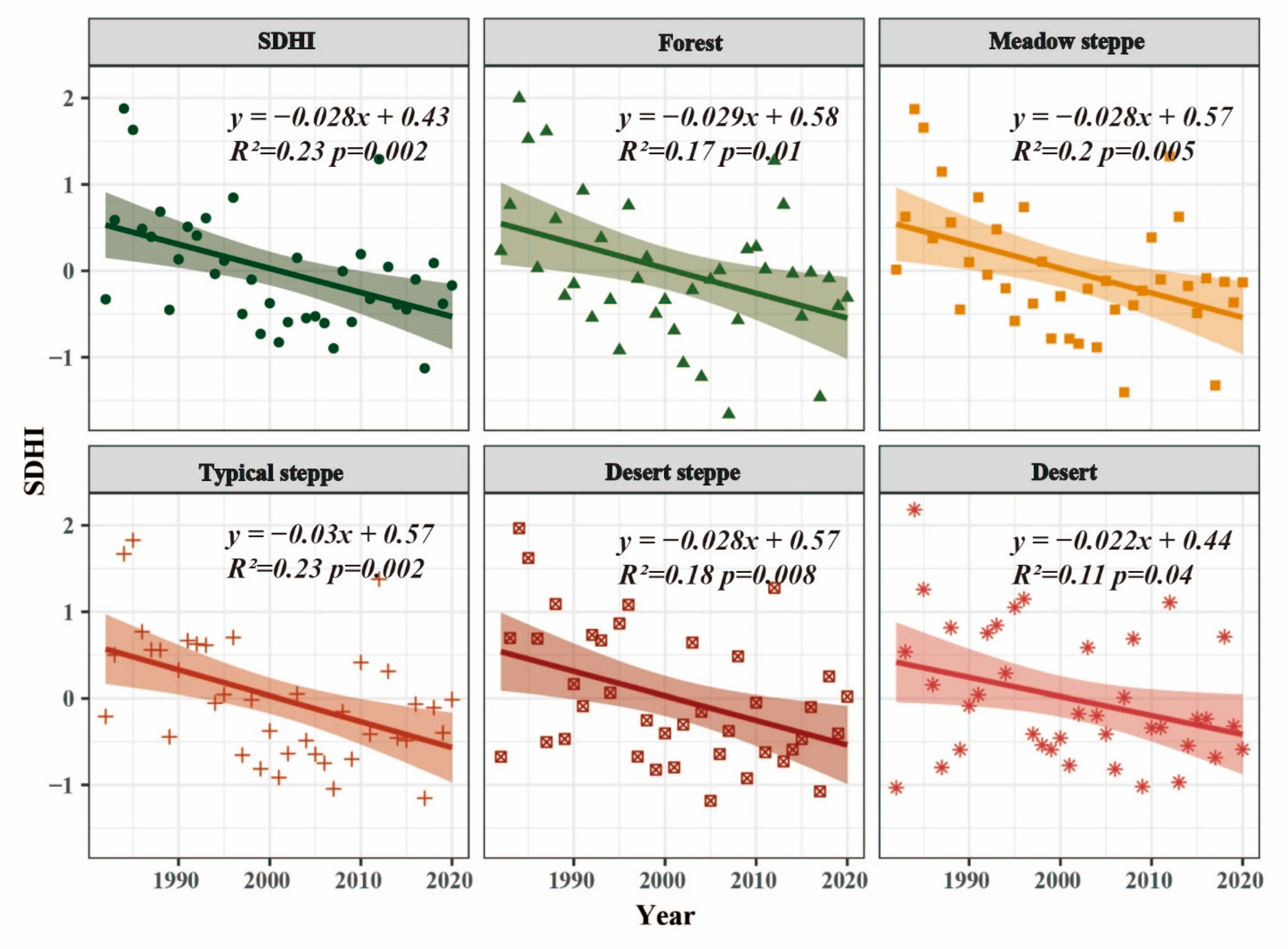
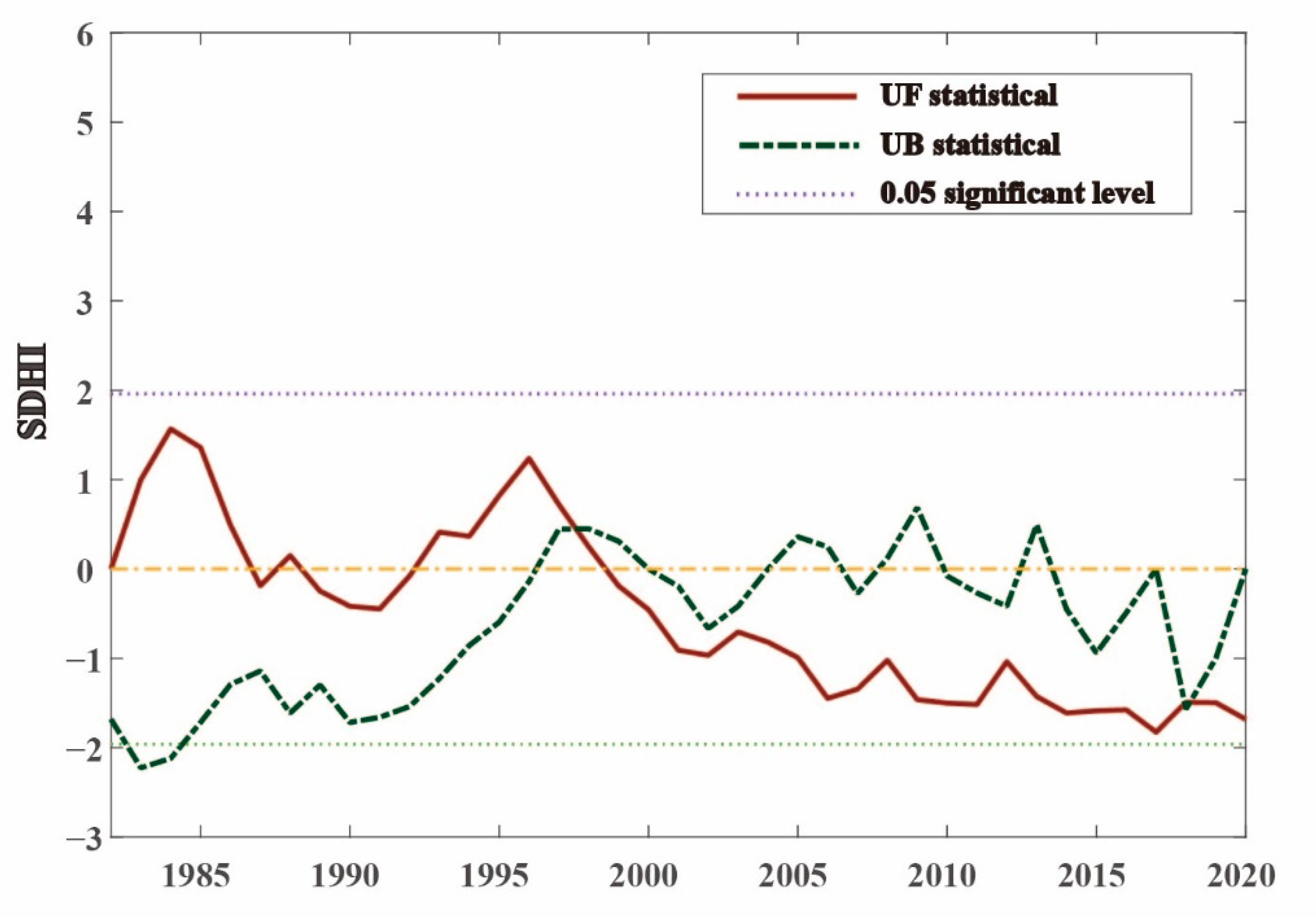
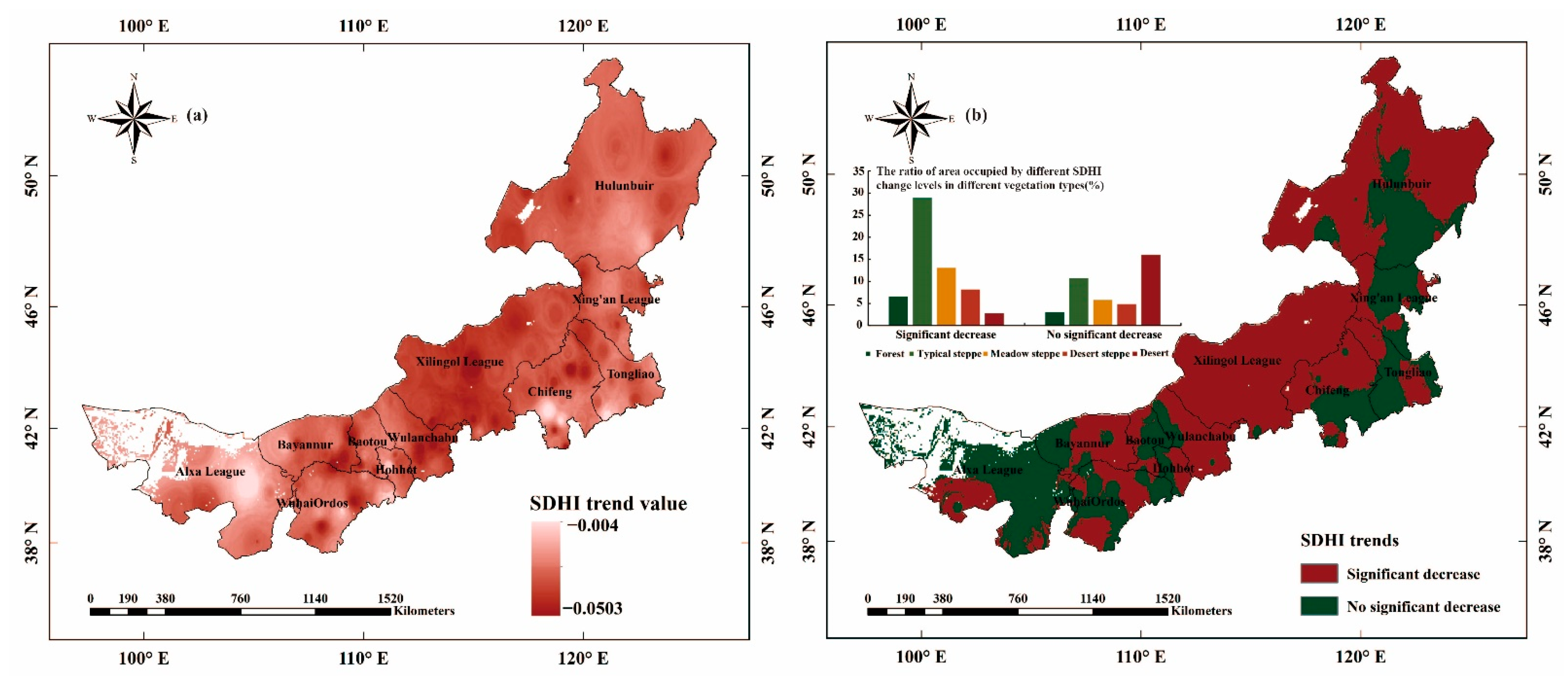

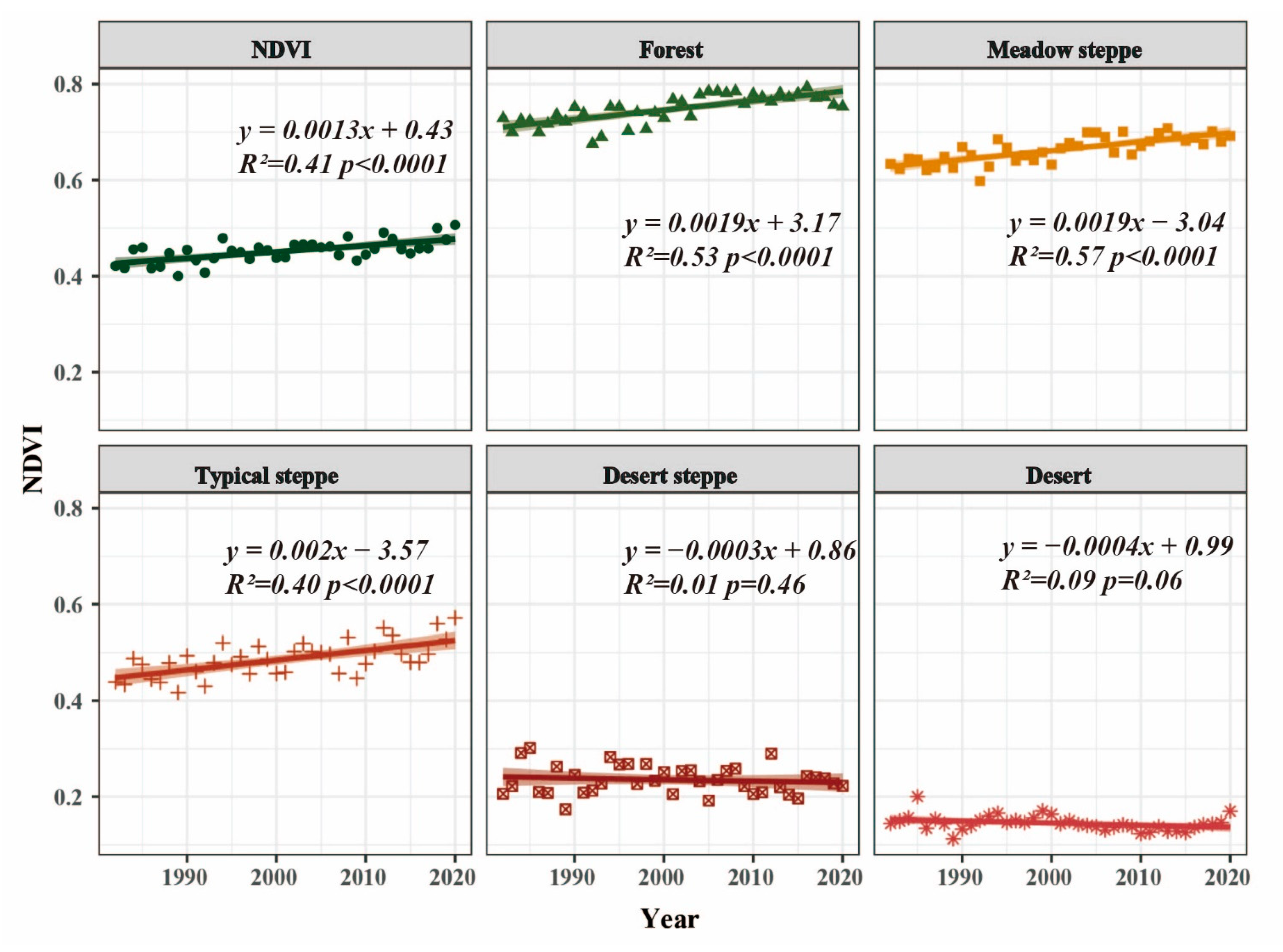


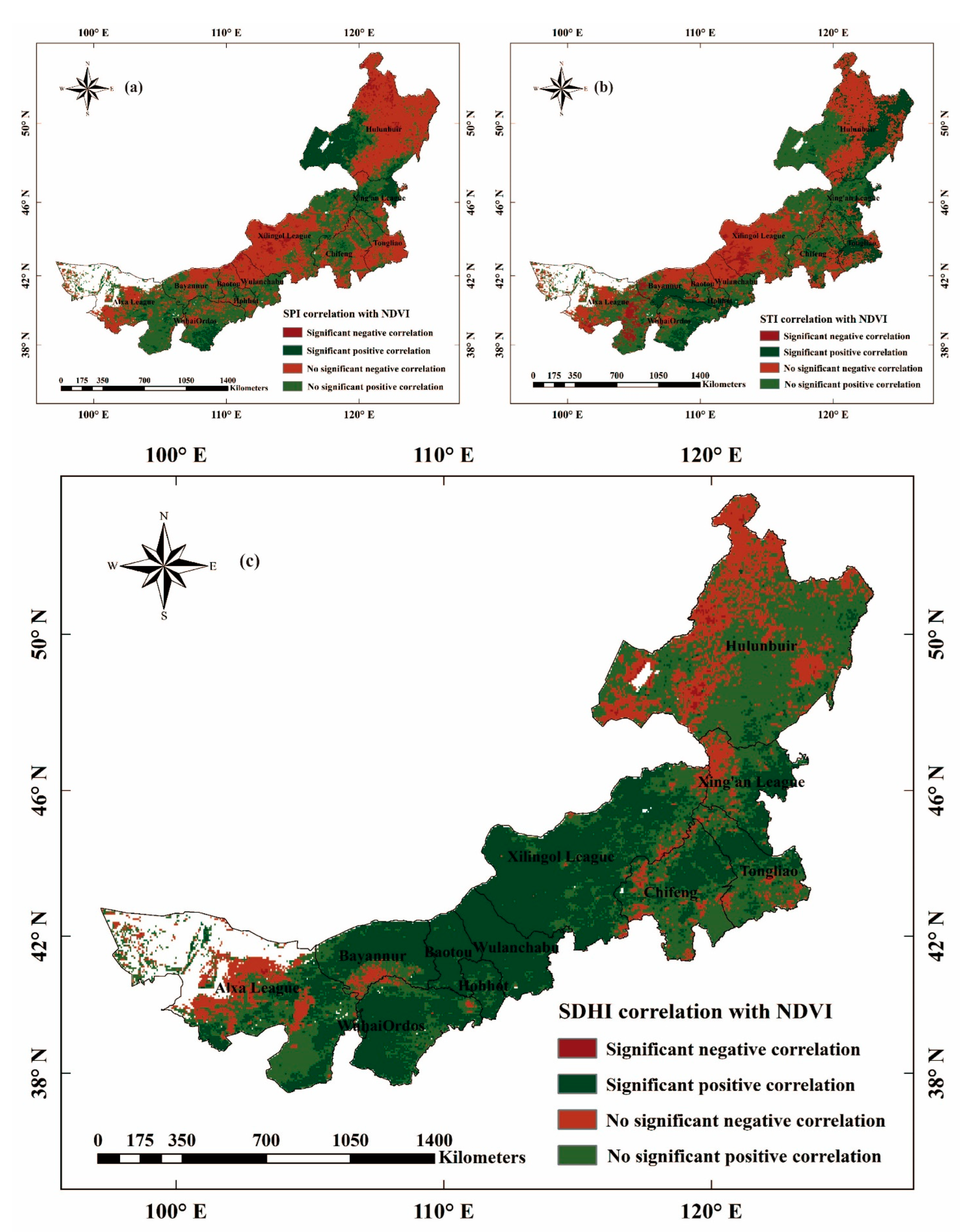
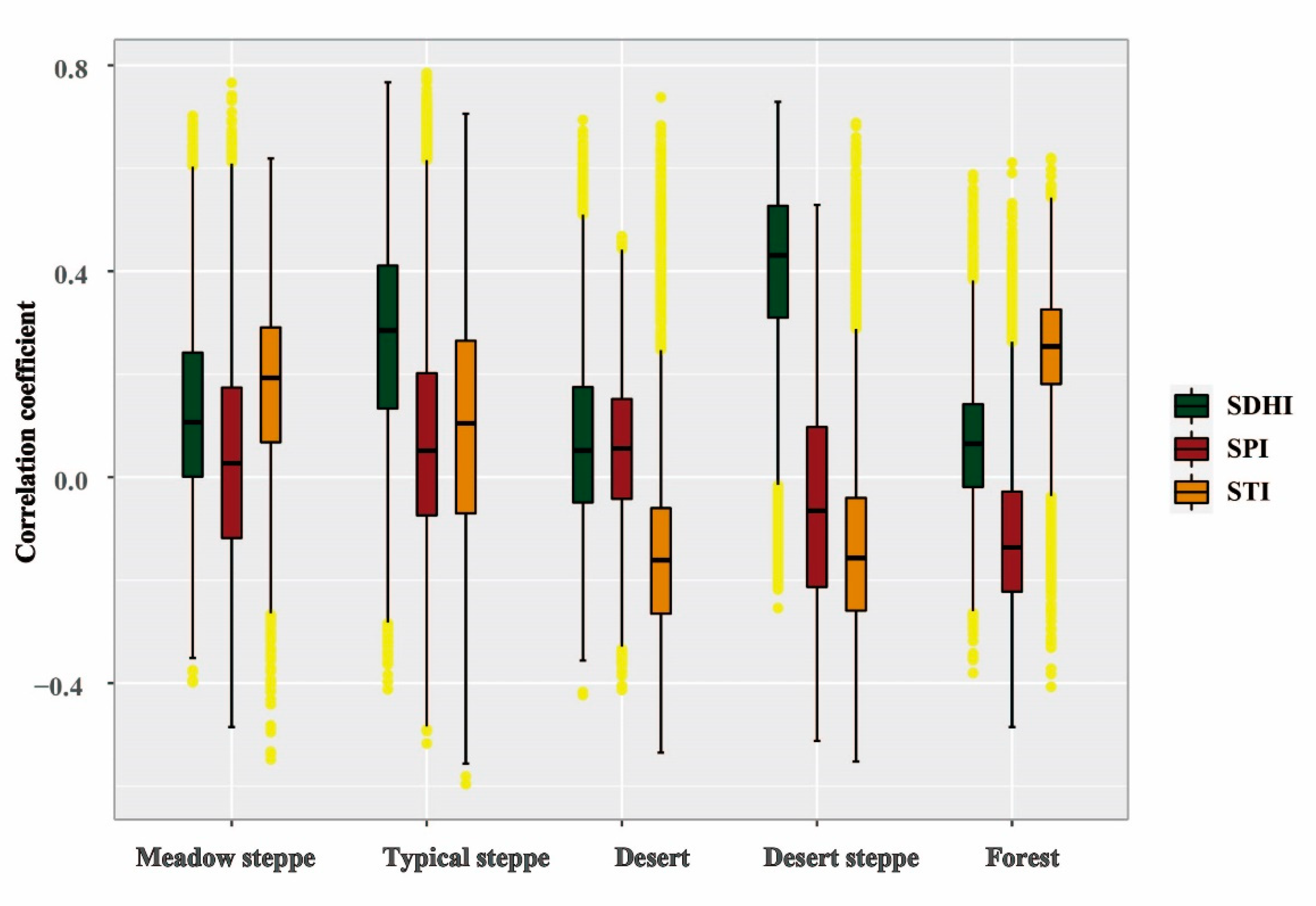


| Dataset | Time Scale | Spatial Scale | Source of Data |
|---|---|---|---|
| Climate dataset | 1982–2020 | – | Meteorological Information Center of the Inner Mongolia Meteorological Bureau |
| NDVI | 1982–2020 | 5 km | http://ltdr.nascom.nasa.gov (accessed on 10 January 2022) |
Publisher’s Note: MDPI stays neutral with regard to jurisdictional claims in published maps and institutional affiliations. |
© 2022 by the authors. Licensee MDPI, Basel, Switzerland. This article is an open access article distributed under the terms and conditions of the Creative Commons Attribution (CC BY) license (https://creativecommons.org/licenses/by/4.0/).
Share and Cite
Kang, Y.; Guo, E.; Wang, Y.; Bao, Y.; Zhao, S.; A, R. Spatiotemporal Variation in Compound Dry and Hot Events and Its Effects on NDVI in Inner Mongolia, China. Remote Sens. 2022, 14, 3977. https://doi.org/10.3390/rs14163977
Kang Y, Guo E, Wang Y, Bao Y, Zhao S, A R. Spatiotemporal Variation in Compound Dry and Hot Events and Its Effects on NDVI in Inner Mongolia, China. Remote Sensing. 2022; 14(16):3977. https://doi.org/10.3390/rs14163977
Chicago/Turabian StyleKang, Yao, Enliang Guo, Yongfang Wang, Yuhai Bao, Shuixia Zhao, and Runa A. 2022. "Spatiotemporal Variation in Compound Dry and Hot Events and Its Effects on NDVI in Inner Mongolia, China" Remote Sensing 14, no. 16: 3977. https://doi.org/10.3390/rs14163977
APA StyleKang, Y., Guo, E., Wang, Y., Bao, Y., Zhao, S., & A, R. (2022). Spatiotemporal Variation in Compound Dry and Hot Events and Its Effects on NDVI in Inner Mongolia, China. Remote Sensing, 14(16), 3977. https://doi.org/10.3390/rs14163977







